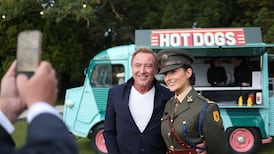January 1916
The Gathering Storm
Meeting Irish Volunteers leader Eoin MacNeill, James Connolly threatens to lead his tiny Irish Citizen Army (ICA) against the British empire. Some members of the Irish Republican Brotherhood (IRB) who have infiltrated the Volunteers later tell Connolly of their plans for an Easter
rebellion, to which he agrees. Connolly joins the IRB shortly afterwards. Michael Collins returns to Ireland from London.
April 21st, Good Friday
Setback
The British navy intercepts the SS Libau, a German cargo ship posing as Norwegian ship the Aud, carrying 20,000 rifles, machine guns and ammunition destined for the rebels. Having failed to make contact with the rebels, the ship is towed to Cork Harbour, where the German crew scuttle the ship.
April 22nd, Easter Saturday
Confusion
MacNeill learns of plans for the next day’s Rising. Knowing it is doomed without the German guns, he countermands mobilisation orders for the following day. Most Volunteers stay at home. Meeting Pearse and the other rebel leaders on the Sunday, Clarke and Connolly insist that the Rising goes ahead the next day, Easter Monday.
April 24th, Easter Monday
Rebellion
In Dublin, about 1,250 rebels occupy the GPO, Jacob’s factory, the Four Courts, St Stephen’s Green, South Dublin Union, Jameson’s, the Mendicity Institution, and Boland’s Mills and Bakery, plus 25 Northumberland Road, Clanwilliam House and the Magazine Fort in the Phoenix Park. Outside the GPO, Pearse proclaims a Republic.
April 26th
Death of a pacifist
Francis Sheehy-Skeffington is summarily executed, along with journalists Thomas Dickson and Patrick McIntyre, at Portobello Barracks, on the orders of Capt JC Bowen-Colthurst.
Sheehy-Skeffington had been arrested the previous day after trying to stop looting, before being used as a hostage during Bowen-Colthurst’s murderous rampage near Kelly’s Corner.
April 27th
Chemical warfare in Europe
With rebellion raging in Dublin, the 47th Brigade, 16th (Irish) Division is decimated in one of the biggest German gas attacks of the first World War, at Hulluch, in France.
Many Irish families have husbands and sons fighting for the British army on the western front.
May 3rd
Executions begin
Pearse, Clarke and McDonagh are executed in Kilmainham Gaol for their part in the Rising, which has killed or injured 1,350 people. Over the coming days, 11 more rebel leaders are executed there. In Cork, Thomas Kent is executed on May 9th in Victoria Barracks after a gun battle with Royal Irish Constabulary men.
May 11th
The ‘Irish Crisis’
In a Westminster debate, John Dillon of the Irish Parliamentary Party calls on the British government to end the executions. The next day, prime minister HH Asquith arrives in Dublin, and Seán Mac Diarmada and Connolly are executed in Kilmainham.
July 1st
The Somme
British and French armies on the western front launch the Somme offensive against Germany. Lasting until November 18th, it is one of the bloodiest battles in history, claiming about one million casualties.
The 36th Ulster Division suffers 5,500 casualties in the first two days alone, while the 16th Irish Division has 4,330 casualties in September, among them 1,200 dead.
Altogether, about 3,500 Irishmen die, with thousands more wounded.
August 3rd
Casement hanged
Having been arrested at Banna Strand, Co Kerry after the failure of the Aud mission, Sir Roger Casement is sent to the Tower of London and, on June 29th, found guilty of high treason.
Turning down appeals from the US senate, WB Yeats, Sir Arthur Conan Doyle and George Bernard Shaw, the British government circulates the “black diaries” said to reveal Casement as a homosexual.
He is hanged at Pentonville Prison.
September
Rebels reappraised
WB Yeats completes Easter 1916. The poem reflects both his own internal conflict about the Rising and a public reassessment of the executed rebels, who have become cult heroes. Its ambiguous refrain also presages the revolutionary convulsions yet to visit Ireland: "A terrible beauty is born."
December 29th
Joyce novel published
A Portrait of the Artist as a Young Man, by James Joyce, is first published complete in book form by WB Huebsch in New York.
The novel traces the intellectual transformation of Stephen Dedalus, the author’s alter ego, including his growing resentment of Catholic Irish culture and his need to emigrate.









